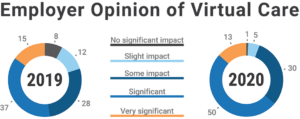Virtual health plays a significant role in care delivery
Employer perception of virtual health—and its value—is changing rapidly. In 2019, a survey by the National Business Group on Health cited that 80 percent of employers believed that virtual solutions would have some or significant impact on the healthcare delivery system. Just one year later, that number was up to 94 percent, a 14-point jump in one year.[1]
Meanwhile the percentage of employers who said it would merely have a slight impact or no impact at all dropped to just six percent.[2]

Employers aren’t the only ones interested in expert medical care at their fingertips. Unsurprisingly, 80 percent of millennials said they would try virtual health as a way to receive healthcare services.[3] Considering that one-third of millennials don’t have a primary care doctor at all, this could be an important way to engage this population of employees in the care they need.[4]
This change in perspective on virtual health solutions marks an important shift in how employers see healthcare services being delivered today and into the future. Employers know that virtual health is a tool that more and more employees want as a benefit, and a place they’re increasingly seeking care.
Why it’s important
Finding sites of care that your employees will use is important for engaging them in their own healthcare, ensuring they get the care they need and don’t show up to work sick. Two-thirds of millennials are hesitant to seek medical care until there’s already a major problem.[5] The healthcare delivery system isn’t working for many people.
If employees can’t access care easily or in a way that’s convenient for them—and the doctor’s office can’t see them when they need it most—they’ll begin looking for care alternatives, which means your employees could end up in urgent care or the emergency room.
Employers realize their employees need healthcare services 24 hours a day, seven days a week. This availability helps stem the flow of services to the more expensive care settings. Virtual health is one such solution, and can help employers break down barriers to care. People who are unlikely to seek care might think otherwise if it were as simple as speaking to someone on their laptop or smartphone. Arkansas Blue Cross and Blue Shield’s virtual health solution boasts an average wait time of less than 10 minutes.
Virtual health services are more than care at any time or place, but a commitment to quality care. Virtual health with Arkansas Blue Cross (powered by MDLIVE) features 24/7/365 availability of board-certified, state-licensed physicians including pediatricians.
Virtual health can be used for non-emergency conditions such as:
- Allergies
- Common cold
- Constipation
- Cough
- Diarrhea
- Ear problems
- Fever
- Flu
- Headache
- Insect bites
- Nausea
- Pink eye
- Rash
- Respiratory problems
- Sore throat
- Urinary problems
- Vomiting
- And more
Fully insured Arkansas Blue Cross and Health Advantage customers have virtual health as part of their benefits. Fully insured group administrators can share this flyer (English | Spanish) with their employees to promote virtual health. Fully insured members can register at MyVirtualHealth.com.
Self-funded groups can include virtual health as part of their health benefits. Learn more about how it works today, and then talk to your BlueAdvantage representative if you’re interested in adding virtual health to your benefit package.
[1] “2020 Large Employers’ Health Care Strategy and Plan Design Survey.” National Business Group on Health: 2019. Online: www.businessgrouphealth.org/en/resources/2020-large-employershealth-care-strategy-and-plan-design-survey (Accessed February 2020).
[2] Ibid.
[3] Blue Cross Blue Shield Association National Generation Survey, 2019.
[4] Ibid.
[5] Ibid
MDLIVE is an independent company providing telehealth services on behalf of Arkansas Blue Cross and Blue Shield, Health Advantage and BlueAdvantage Administrators of Arkansas.